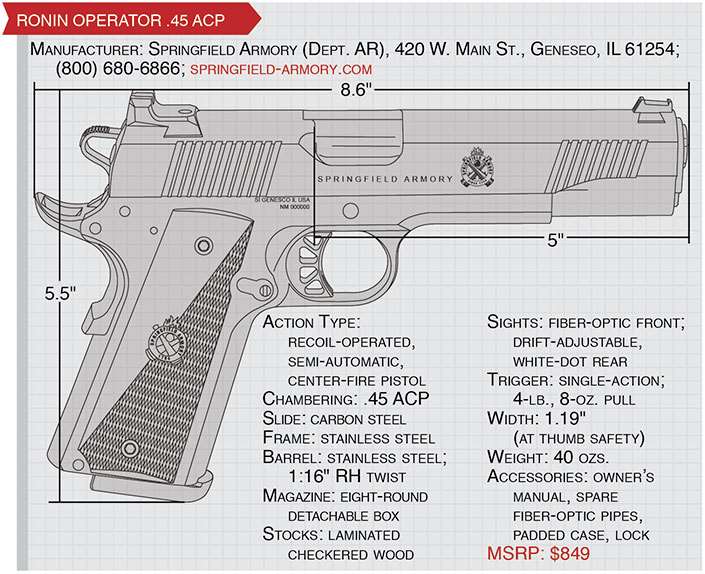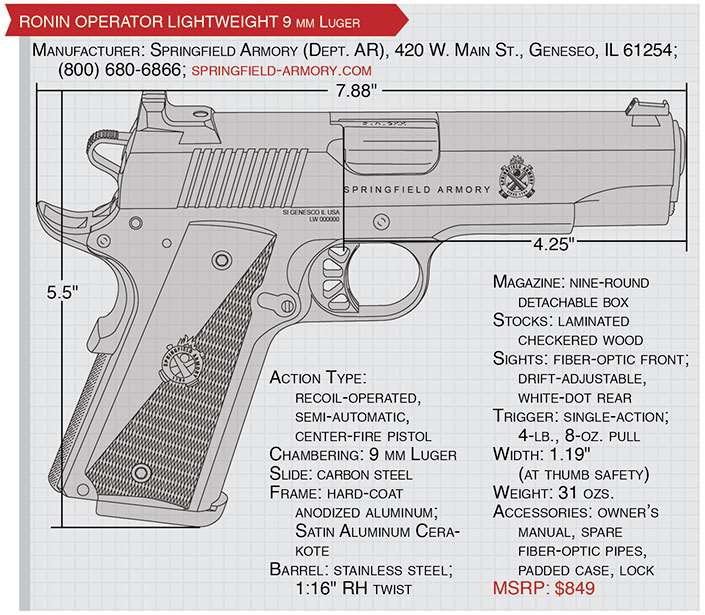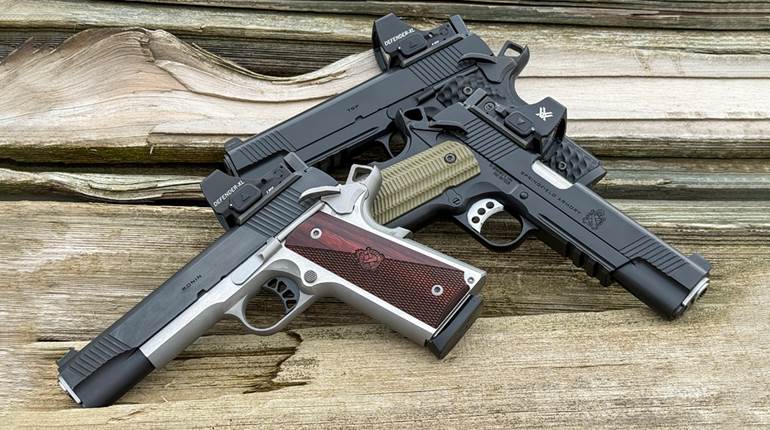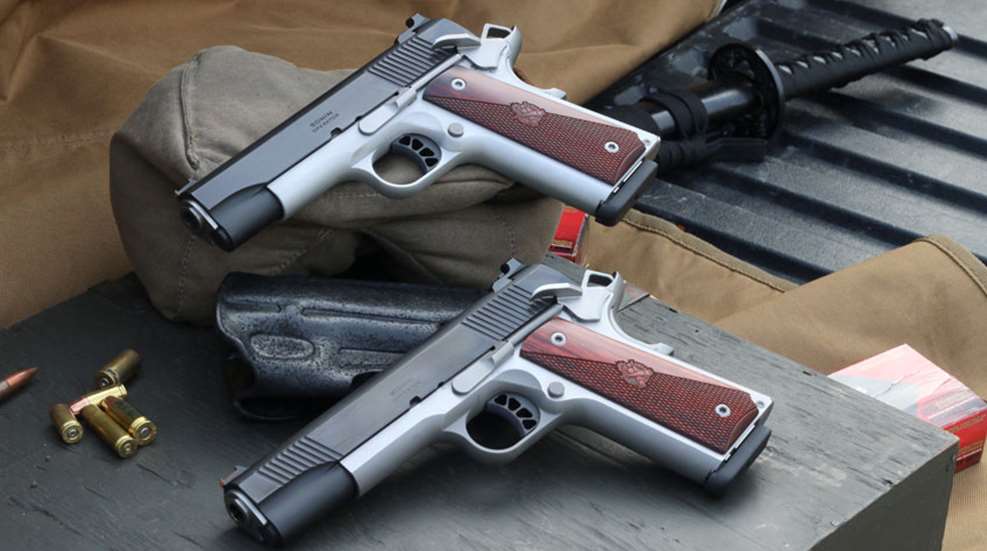
The Ronin line packs a number of popular features into a pistol at a head-turning price point. M1911s have been specialized into any number of applications over the years, but the Ronin appears to be aimed at the intersection of defensive use and practical competition.
I’ve been an M1911 fan since I was a teenager. It is well-known that many folks’ definitive taste in music and “good” movies tends to be set in that time period between getting a learner’s permit and the mid-20s.
In a similar way, when I see a well-appointed two-tone M1911 I can’t help but think back to early magazine images of custom “combat” M1911s, such as the iconic Pachmayr Combat Special.
The hard-chromed frame/blued slide combo with custom beavertail, sights and match trigger was the classic custom look for quite a few years across most of the big-name custom pistolsmiths who were giants of the ’80s and ‘90s. So, not surprisingly, the Ronin immediately jumped out at me as a striking pistol in the very best retro kind of way.
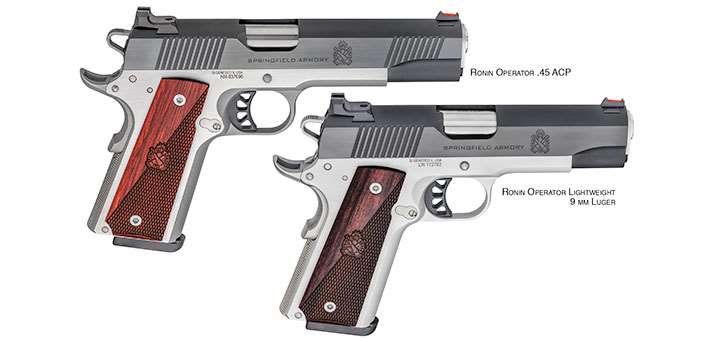
The Ronin is available in both steel and aluminum frames, as well as the traditional 5" and 4.25" barrel lengths, chambered in both 9 mm Luger and .45 ACP. I tested the fullsize steel .45 and a Ronin Lightweight in the 4.25" 9 mm trim, which, by the way, is a standard-bushing design.
During the course of several weeks, I put a little more than 1,200 rounds through the two Springfields. The M1911 world is so well-established as to be a bit predictable at times, but these two are worth talking about. The real story here is the level of quality and performance in a forged M1911 at a very attractive price.
It is nice to see a well-blued pistol in 2020. Various painted and polymer-based finishes are certainly more practical, but no one gets into an M1911 for purely utilitarian appeal.
The Ronin is nicely polished on the flats and matted on the rounds with attractive, even roll marks. The bluing is nicely done, something that is no longer a given as the industry has largely moved beyond bluing as the default firearm finish.
That level of detail extends to other features around the guns. The beavertail safety is closely fit for a factory pistol, preventing the annoying wiggle and rattle that accompanies sloppy tolerances and unsightly seams on some M1911s.
The fiber-optic front sight is dovetailed into the slide with the seam between the slide and sight very closely matched in contour, almost appearing to be blended, which is also unusual in a factory M1911.

The extended, single-sided thumb safety snicks on and off with the ideal amount of resistance; firmly in place, it easily disengages as the thumb presses it.
I am admittedly picky about this point, and rarely find a factory M1911 with the thumb safety fitted to my satisfaction. Cycling either Ronin, the slide-to-frame fit was firm yet smooth. The lockup was encouragingly tight.
The sights on the Ronin have a serrated rear face with two white dots, a shelf on the front face to facilitate one-handed racking of the slide and ample light in the 0.120" notch.
The 0.125" front sight’s fiber-optic rod is a nice diameter that gathers light easily without being overpowering if the shooter is using the notch and post. I found the combination to be excellent in both speed at close range and in precision shooting at greater distance.
If I could change anything about the sights I might delete the white dots, but many will like them as they are. This is as good a time as any to initiate a “slow clap” for the industry at large.
In the past few years sights released on pistols have been excellent overall. The days of needing to immediately replace sights or make do with less than ideal units seem to be behind us, with a thriving aftermarket to account for those with distinct preferences.
Some people buy M1911s for the history, the mystique, the legends … but the reason those aspects endure is really because of the trigger. The unparalleled M1911 trigger is the key to its appeal and longevity, and the pair of Ronins had triggers like you hear about. The triggers each released crisply right at 4 lbs., 8 ozs., of pull with no overtravel.
The triggers were in that happy convergence where competitors, defensive shooters and pleasure shooters will all be satisfied. I’ve paid for trigger work in the old days that didn’t result in pulls this nice.
I was struck by how identical the two triggers were in feel. Between the lockup and the quality of the triggers, I was eager to get to the actual shooting.
The accuracy of the two Ronins was simply outstanding. Springfield Armory has long experience with the M1911 and well-established semi-custom models at higher price points where you might expect this level of consistency, but I was genuinely pleased with the results.
Shooting a test gun for accuracy is always a love/hate affair for me. It is deeply satisfying to punch little 1.25" clusters, but when a pistol is, as the euphemism goes, “combat accurate” and slinging 3"-plus groups, the fun drains right out of it. I end up wondering if I am on call or sneaking some slight flinch into my trigger squeeze.
In this case, I was enjoying each walk down to the target to see the result, gaining respect for and confidence in the pistols with each new group. I tested the Ronins in variable high winds, so, if anything, they likely shoot a bit better than I recorded, and the two pistols had the statistically improbable result across 30 groups of tying exactly at a 1.66" three-load average.
Even better, the results weren’t limited to just high-end factory fare, with my go-to training handloads also bracketing from 0.80" to 1.50" in the two pistols. Hornady’s 230-gr. HAP over 5.3 grs. of HP 38 was a standout, punching cloverleafs that averaged 1.03".
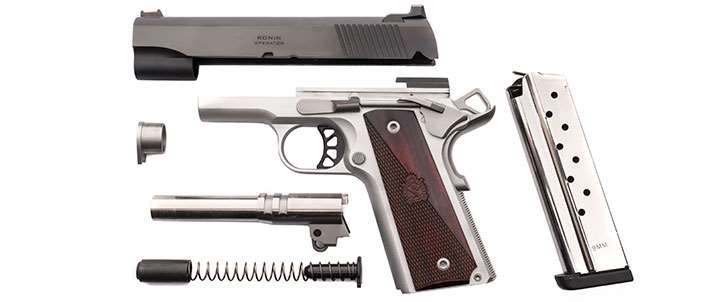
The Ronin line uses thin screw bushings and a slim set of laminated rosewood stocks that are partially checkered. While my preference is for standard-thickness stocks, I had surprisingly good control with the thin units and suspect that many shooters with a variety of hand sizes will quite like them.
The downside to thin units is that it’s not possible for the traditional shelf on the inboard panel to support the plunger tube in case it becomes loose. Springfield addresses this by both staking and using locking compound to secure the plunger tube to the frame.
I ran both pistols through a wide variety of standards and drills. With both pistols my times on the 10-yd. plate racks were near enough to my personal bests with 9 mm and .45 ACP to suggest real promise.
After seeing the accuracy each Ronin was capable of, I skipped right past “normal” challenging drills and went right to the really hard stuff that is impractical with most handguns.
Both pistols were quickly putting four out of five shots on a little 3"x6" plate out at about 40 yds. I then walked back to the 70-yd. line to see what the Ronins would do. The Ronin Lightweight 9 mm flattened four of five Sellier & Bellot 150-gr. flat points onto my 8" plate, which is exceptional.
Once I had a sense of the proper hold for the Ronin .45 with the Wilson .45 match loads, the pistol rang the plate five straight, each deep bass tone of a 200-gr. impact punctuating the achievement. I’ve previously only gone five straight with custom and semi-custom pistols with which I am very familiar, so I was impressed.
It is beyond any reasonable expectation to simply walk back with a new, out-of-the box factory pistol and hold groups on an 8" plate at 70 yds. In the Ronins the inherent accuracy came together with good sights and great triggers to allow exceptional work.
With the “extreme feats of accuracy” box thoroughly checked, I moved onto more practical tests. I fired each Ronin on the 10 Second Showdown, an advanced, 3- to 13-yd. dynamic drill that incorporates draw, reload, movement and shooting on the move (full details of the drill can be seen here). The .45 scored a 98 and the Commander-length 9 mm aced the drill once I got a little practice with the reloads.
I was once issued one of the small number of Marine Corps M45s built by the Springfield Armory Custom Shop, and, in tribute to that excellent pistol, I fired the Ronin .45 through my old unit’s pistol qualification.
Not surprisingly, the Ronin did fine. The two new pistols were performing about as well I am able to make any pistol deliver on challenging, practical tests.
Looking at the features of the Ronin Operators you can see where a chunk of shooters would see this as a viable pistol for practical competition such as International Defensive Pistol Ass’n (IDPA) or other action disciplines. To check that box as well, I fired both pistols on the IDPA 5x5 qualifier, which has a variety of rapid-fire strings on a 10-yd. target.
Both pistols made the Master level qualification for their respective divisions with a comfortable buffer. Undoubtedly competitors will set up a pistol to their liking (M1911 shooters tend to be tinkerers, and tinkers gotta “tink”) but either of these guns could go from the box to the match successfully.
I found the Ronin Lightweight to be a near perfect match to the recoil of the 9 mm Luger cartridge. The aluminum frame gave it quick handling from the holster and target to target, but at about 34 ozs. loaded had just enough heft to steady the gun and absorb recoil.
The hammer-fired ignition softened recoil considerably as the slide’s rearward movement is attenuated by re-cocking the hammer and resetting the mainspring.
I’m always a fan of nice checkering or stippling on a M1911 frame, but on the Ronin 9 mm, the lack thereof was barely noticeable in recoil. The frame of the Ronin .45 would benefit from some additional traction, but that is probably not realistic on an American-made, forged-frame pistol at this price.
I did find the matte finish on the stainless steel gave some purchase on the frontstrap, but that may not be as distinct as summer brings on sweaty hands.
Reliability is always a pressing question when dealing with a new M1911. Extractor tension was good in both pistols, leading to consistent and predictable ejection. Each Ronin fed a wide range of bullet weights, styles and velocities with zero complaint.
The 9 mm version has a ramped barrel, while the .45 uses the traditional barrel with a nicely throated feed ramp. Each pistol shipped with a single magazine, an eight-round Mec-Gar for the .45 and a nine rounder for the 9 mm. I fired both pistols with a variety of magazines to ensure compatibility.
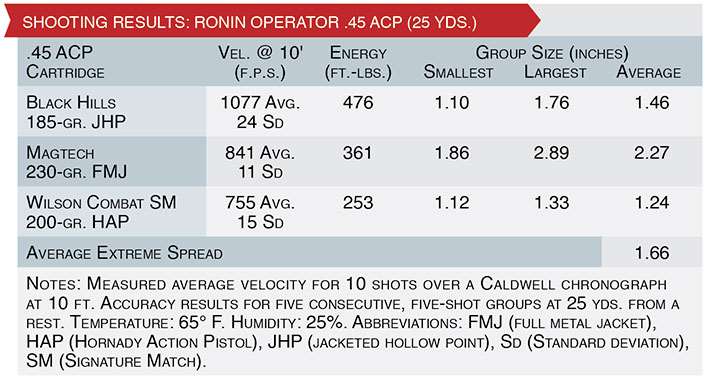
The .45 worked smoothly with both the traditional Wilson Combat 47s and the new 500-series eight-round magazines. I have always been partial to the seven-round 47s, and struggled to seat magazines with the slide forward using the eight-round 47Ds. The new 500 series is even more robust and seats easily with a full eight rounds.
The Ronin 9 mm ran smoothly with the 10-round Wilson Combat 500 series. I cleaned the 9 mm once at about 200 rounds for photos and added a few drops of Ultima Lube Lite Oil on each range trip. The .45 never did get a cleaning and was running smoothly 650 rounds in with only the light oiling on each session.
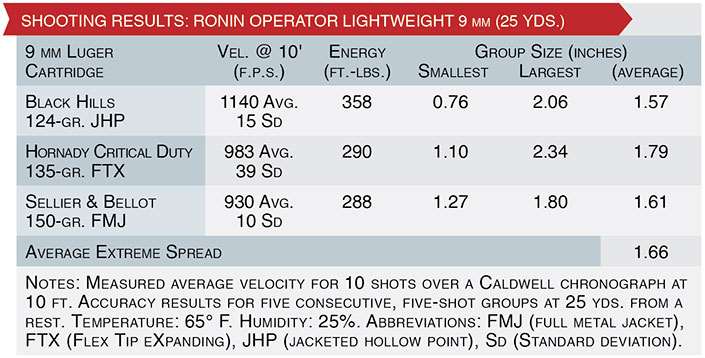
In the world of M1911s there is a broad spectrum of price and quality—ranging from inexpensive offshore bangers to the various domestic production models and semi-custom guns to highly bespoke models with years-long wait times. Regardless of the MSRP, the two Ronin samples here were at the very top end of production quality.
In terms of fit and finish, they compete strongly with models at significantly higher prices. In terms of performance, the Springfields’ triggers, accuracy and reliability are awfully close to what a shooter would hope for in a semi-custom M1911 (meaning a mostly production-line-made pistol, with varying degrees of hand-fitting of key components).
Having been around a wide range of M1911s personally and professionally, the Ronin is a factory M1911 that in many ways exceeds the quality of the local custom pistolsmiths of my early years.
The M1911 market remains vibrant, and pistols like the Ronins will continue to win the iconic American sidearm more fans. I can see the Ronin being the ideal introduction to the M1911 for many shooters and a happy addition for longtime M1911 pistoleros.
